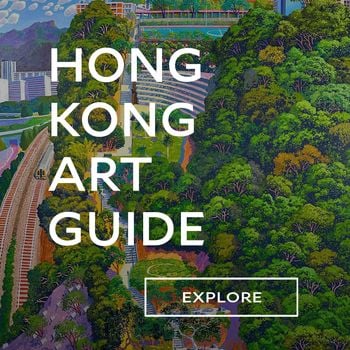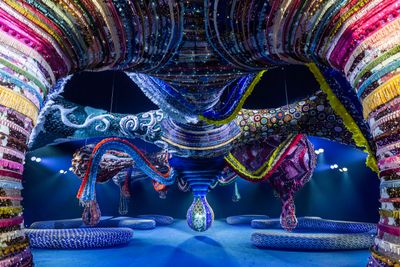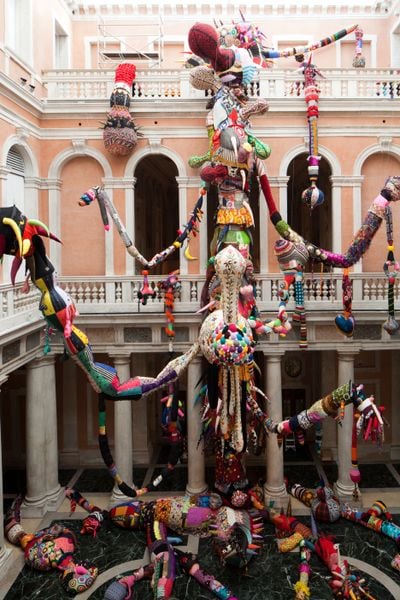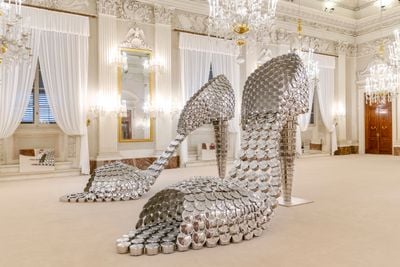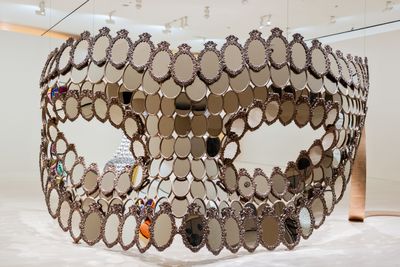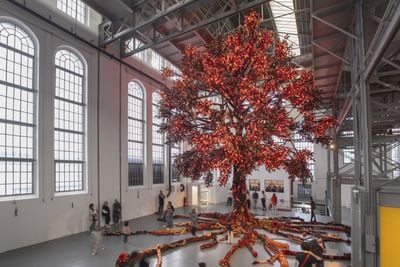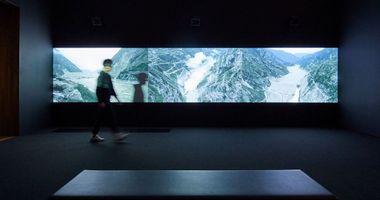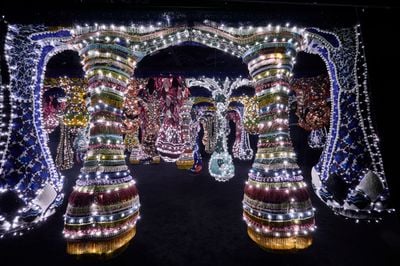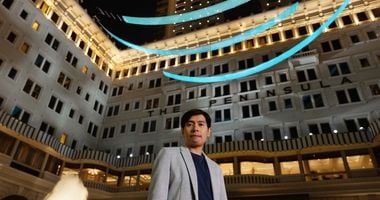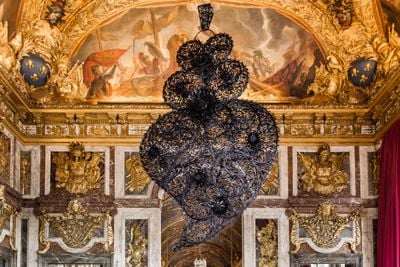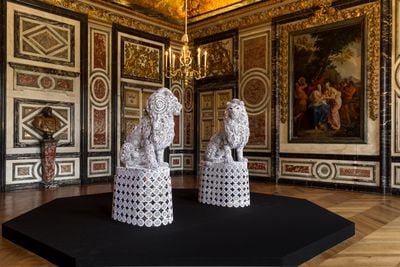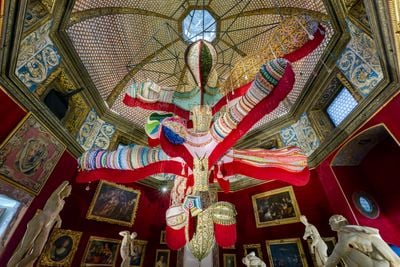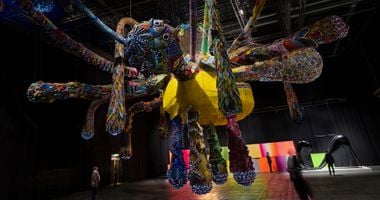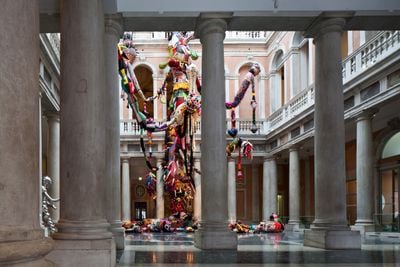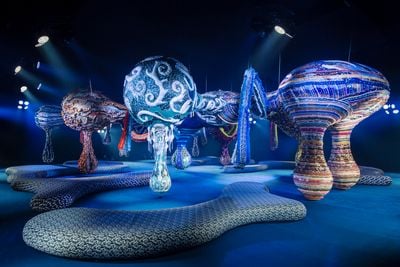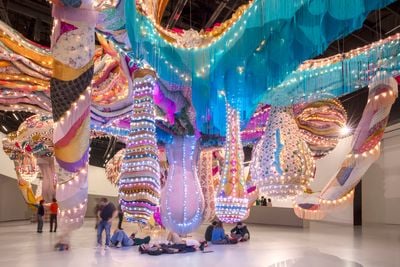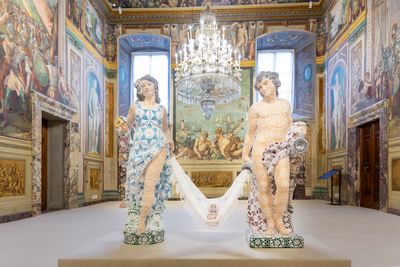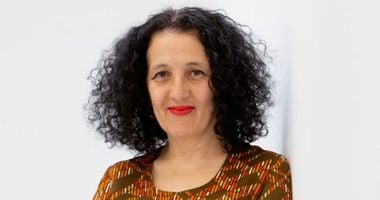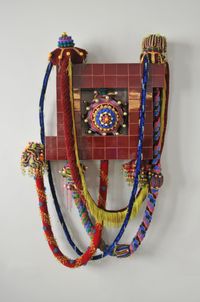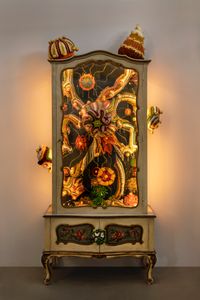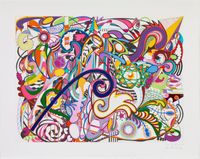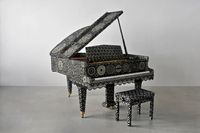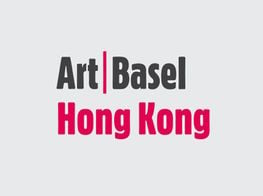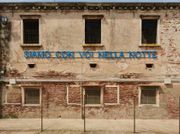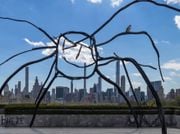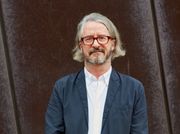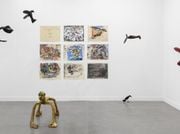Joana Vasconcelos: 'What's Important is Atmosphere'
Joana Vasconcelos. Courtesy the artist. Photo: © Lionel Balteiro.
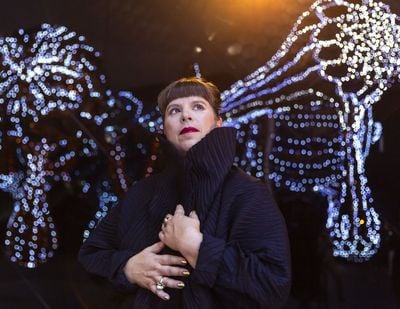
Joana Vasconcelos. Courtesy the artist. Photo: © Lionel Balteiro.
Born into an artistic family in 1971, Portuguese artist Joana Vasconcelos has built a celebrated 30-year career with her massive installations of hand-crafted sculptures assembled from embroidered, crocheted, and knitted elements.
Employing a small army of artisans in her huge Lisbon studio, Vasconcelos creates serial works that honour women whose contributions to history are overlooked. Take the colourful 'Valkyries' (c. 2004–ongoing), inspired by the female figures of Norse mythology who flew over battlefields and brought the bravest warriors back to life to join the deities in Valhalla.
The series has paid homage to people such as Elizabeth Freeman, an enslaved African-American woman whose court battle for her freedom in 1781 helped make slavery illegal in Massachusetts and Catherine Dior, a member of the French resistance who suffered in a concentration camp before becoming a florist to share beauty with her countrymen.
Vasconcelos got her first big break in 2000 after receiving the inaugural New Artists Award from EDP Foundation. Expanding her artistic development through exhibitions primarily in Portugal and Spain, her gigantic chandelier made from 14,000 OB tampons—ironically titled The Bride (2001)—was featured in the 2005 Venice Biennale, which brought international attention to her controversial mingling of high and low art.
Citing Duchamp and Judd among influences, the artist has also made works that decontextualise everyday objects, including traditional ceramic figurines covered in woven materials and symbolic sculptures constructed from consumer goods.
In 2008, Vasconcelos had her initial museum show in Brazil at Pinacoteca do Estado de São Paulo. There, she created her first 'Contamination' piece, a sprawling sculptural installation made with sewn and handwoven elements that would lead to her later 'Valkyries'.
The artist made headlines again in 2012 when she became the first woman artist to have a solo show at Château de Versailles outside Paris. The Bride was banned from the exhibition but Vasconcelos hit a feminist chord with her giant pair of high-heeled shoes, titled Marilyn (2011) and amusingly assembled from overlapping stainless steel cooking pans and lids.
Her presentation at Versailles made such a stir that she was invited to represent Portugal at the 2013 Venice Biennale. There, she created a floating pavilion that ferried visitors between the Arsenale, Giardini, and Punta della Dogana.
On the cacilheiro boat covered in traditional Portuguese blue-and-white azulejo tiles, the artist painted a contemporary view of Lisbon's skyline. The image was inspired by Gabriel del Barco's Great Panorama of Lisbon (c. 1700), depicting the city before the 1755 earthquake. On the deck, the artist constructed one of her signature-style environments of textiles and light that encased visitors in a womb-like sphere.
The fearless artist had a retrospective at Guggenheim Bilbao, Spain, in 2018. I'm Your Mirror featured some 30 pieces produced over 20 years, including I'll Be Your Mirror, a colossal Venetian mask made from 255 baroque bronze mouldings, designed and decorated by the artist, and 510 mirrors superimposed as if they were scales, and the monumental Valkyrie Egeria (both 2018).
Not to stop there, Vasconcelos created Tree of Life (2023), a 13-metre-high sculpture with 354 fabricated branches and 140,000 hand-embroidered fabric leaves, which her team sewed at home during the Covid-19 pandemic in 2022, and Valkyrie Miss Dior, a collaboration with the French House of Dior for its 2023 fashion show at Jardin des Tuileries in Paris.
The artist currently has two major museum shows on view: Plug-in at Museum of Art, Architecture and Technology in Lisbon (until 8 April 2024) and Extravagances at Oscar Niemeyer Museum in Curitiba, Brazil (until 22 September 2024).
During Art Basel Hong Kong, ArtisTree opened the artist's first immersive installations in Hong Kong. Offering a dialogue of space, myth, and textures, her seemingly infinite, site-specific Enchanted Forest installation, on view until 28 April, is one of the highlighted programmes of Swire Properties Arts Month 2024.
Visualising an ethereal forest with sculptural forms illuminated by LED lights, the hand-crafted, kaleidoscopic forest transcends notions of time and space at ArtisTree, while Vasconcelos' Valkyrie Seondeok dominates the lobby of Two Taikoo Place.
The newest textile sculpture is from Vasconcelos' long-running 'Valkyries' series, inspired by powerful women who have made a difference in the world. The giant amorphous structure pays homage to Seondeok, the second female sovereign in recorded East Asian history and the first reigning queen of Silla, one of the Three Kingdoms of Korea, from 632 to 647.
While preparing to install the Hong Kong exhibition, Vasconcelos paused to talk with Ocula about the development of her phenomenal 30-year career, a selection of her recent works, and the new pieces she has unveiled in Hong Kong.
PLDid you study creative practices in school that you still use today?
JVI was trained as a jewellery maker and in a way, I still think like one. The only difference is the scale of the work. The construction of my sculptural projects comes from my jewellery background. When you are constructing jewellery, if you don't get it right you have to start over. It's like glass. When it breaks, it breaks.
I studied glass and ceramics, but I studied jewellery most seriously. I was able to experiment with all those mediums in school. It was quite a privilege because I got to work with materials that I continue to use in my daily practice. I draw a lot, too. I use my background in drawing, and the rest of the work is pretty much built like a jewellery piece.
PLHave you mastered all the other skills that are involved in your art, or do you depend on artisans to help realise your ideas?
JVYes, I know how to knit, crochet, and sew. Of course, I'm not as masterful as my artisans; I just do it from time to time. But in the beginning, I had to do it all. I spent many hours knitting or crocheting. After a while, I thought, if I spend eight hours doing everything, I will only produce one piece at a time. So, I decided to try something else. Let's have more people working. Instead of knitting all day, I can make multiple pieces at once.
PLAre you particularly interested in highlighting Portuguese crafts?
JVNot particularly, but I am a Portuguese artist. Portuguese culture inspires me. I'm based in Portugal and my country's crafts have surrounded me since childhood. Why should I look elsewhere?
PLThere is a bigger emphasis on craft in your artwork, but your work also uses technology. What role does technology play in your practice?
JVI try to combine technology with crafts, although I give more emphasis to crafts. I bring crafts to the forefront of my work. But in the background, there's always technology.
PLYou also have an interest in the readymade and the subversion of existing objects. How do these contemporary concepts get woven into your work?
JVI was born into a lineage of conceptual artists where Marcel Duchamp changed everything. I was also born at a time when a woman could become an artist. I had to consider, 'Where do I fit? Where do I belong? What kind of conceptual work should I do?'
Then, many artists worked on the readymade and Nouveau Réalisme. In that family, I recognise my work as Pop art, but in the realm of Nouveau Réalisme and Conceptual art, too. Donald Judd is a big inspiration for me, although my work is different. I completely understand his work.
PLI'm a big fan of Nouveau Réalisme.
JVI love Nouveau Réalisme but with a big difference. In Nouveau Réalisme and Pop art, artists acted upon the object; they transformed or interpreted it. But I use the object exactly as it is.
Like Nouveau Réalistes and Pop artists, I decontextualise the object from daily life. This conceptual movement is something Duchamp started. Many of us have tried different approaches, I just do it in another way.
PLWhat are you exhibiting at ArtisTree and Two Taikoo Place in Hong Kong?
JVI'm doing a new installation with elements from the Dior project that were previously exhibited around the world. I've brought them together and rearranged them into an installation called Enchanted Forest. It's a magical dimension where you enter and wander around a poetic space. It's about altering your identity and finding yourself in another realm.
PLHow long did you work on it and with how many workers?
JVThe whole studio of around 60 people worked on it for about six months.
PLHow do these large projects begin and develop?
JVI do a drawing and then it goes to the architectural department and they make a plan with more detailed drawings. Next, we make a 3D model to see how it will fit the space. Enchanted Forest was trickier. We had never built anything like it. It was difficult to put the pieces together; it needed a certain dynamic. So we made maquettes, 3D projects, and a lot of drawings to understand it.
We then tried it out in the studio. We put all the pieces on the floor, and I had to choose which one would go next to the other. Until it's installed, I don't know what the effect will be. I'm super anxious to see what it becomes.
PLWhat do you hope viewers take away from this immersive experience?
JVI hope people will come out of it happy—that magical moments will come out of experiencing something new. I hope that it will make people believe that we can build a different world—one that develops from creativity.
PLYou've become internationally recognised for your expansive 'Valkyrie' installations, which pay homage to powerful women of historical importance. When did you create your first 'Valkyrie' and how have they evolved?
JVI created my first 'Valkyrie' when I was invited to do a television programme in São Paulo around 2004. They wanted to interview me and asked me to bring examples of my work. I made small pieces, which were the proto-Valkyries, and took them in my luggage. Later I thought, I could make these bigger. I've been making them now for about 20 years.
PLHow do these works differ from the 'Contamination' pieces you made for the octagon of Pinacoteca do Estado de São Paulo in Brazil?
JVThe 'Contamination' installations are large, but they're not like the 'Valkyries'. The 'Valkyries' have big, suspended bodies, but the 'Contamination' pieces expand through their buildings.
We built that São Paulo piece in the studio and then I enlarged it with the help of the museum staff over three weeks. It was quite interesting because it ended up being tailor-made for the space. It adapted in a very intimate way to the building.
Then I took it to Lisbon, and later to Palazzo Grassi in Venice, where I adapted it again to the space. It was very striking. Everyone was like, 'Oh my god, what kind of artwork is this?'
PLI was recently at the Pinacoteca in São Paulo and saw the space where you had exhibited it. Like Palazzo Grassi, it has open windows that look into a central space.
JVThe open windows motivated me to show that piece in Venice. When I went to see the space, I saw that I could present that 'Contamination' piece like I did in São Paulo. It worked amazingly in Palazzo Grassi, too.
PLDo you call a piece like that a 'Contamination' because it spreads throughout the space?
JVYes, that's the idea—a positive contamination but it is a contamination.
PLHow complex is Valkyrie Seondeok, the other work that you are exhibiting in Hong Kong?
JVI have different groups of 'Valkyries': small, medium, large, and very large ones. Valkyrie Seondeok is a medium one. It's not one of the biggest, but it's a beautiful piece.
PLWho does Valkyrie Seondeok honour?
JVWe looked at the history of important Asian queens and discovered [Queen] Seondeok. She was the second female sovereign in recorded East Asian history and the first reigning queen of Silla, one of the Three Kingdoms of Korea, from 632 to 647. She was an important woman throughout her reign and modern in her time.
Through these works, we've been discovering forgotten women from all parts of the world.
We were impressed with the way she ruled. She was concerned with the well-being of her people and their surroundings, and she had a big interest in the arts. Through these works, we've been discovering forgotten women from all parts of the world. It's also a way to learn about the history of a place through the women who were from it.
PLYou currently have a survey in Lisbon at Museum of Art, Architecture and Technology (MAAT), which was founded by Energias de Portugal (EDP), the company that gave you the New Artists Award in 2000.
What is it like to come full circle, from an important award in your career to a major exhibition at the museum built by the company that gave you the award?
JVIt made sense to me because I've exhibited in EDP spaces since the beginning. When I earned the award in 2000, they had no collection or museum space. I did a show in the space that they had, which was pretty rough, and then another. So, I've long been part of the family.
It's a privilege to be part of the birth of a museum. When it opened in 2016 I thought, one day I will have a big exhibition there, which I have now done. In a way, it's a homecoming, but it's also about showing my local audience what I've been exhibiting around the world.
PLIt's a beautifully designed museum. I thought it was the perfect place for your work when I saw the Plug-in exhibition last fall. Your work was dynamically displayed, both indoors and on the museum's waterfront plaza.
JVYes, it worked well and I was happy that they acquired the wedding ring [Solitaire, 2018]. It's become part of the city now, which is pretty cool.
PLHow did you decide on the selection of the works, and which pieces were you most excited about sharing with your hometown audience?
JVAll of the pieces were related to electricity and the exhibition was titled Plug-in to connect my body of work and technology. To properly see the works in the show, they had to be plugged in. That was the initial concept.
Then we added some of my most recent works, including Tree of Life, a large work made during the Covid-19 lockdown. It's an important piece because it was a very intense and difficult moment. I wanted to remember the pandemic and that moment of isolation.
The tree was a huge effort but I wanted to note a new beginning, which would also signify hope, that you can always come out of things and do something else. My team got together and decided that we would accept the risk of doing the project. Everyone went home to embroider the leaves. Many people were lonely, others were afraid. A lot of feelings went into that piece. It was created in a unique period of history.
At the same time, however, it was a collective moment. I wanted to highlight that moment in the sense of how it was made, piece by piece by individuals working together. I also wanted it to have an international meaning, which is why I decided on Tree of Life. It's something that is understood by everybody, everywhere around the world.
PLWhen I saw your sprawling Valkyrie Octopus (2015) in Plug-in, I was amazed to discover that it was a huge inflatable sculpture. How did you come up with this idea of embellishing inflatable material, which could be expanded to a massive scale?
JVWell, at the beginning the sculptures weren't inflatable. I was just creating volume—like I did with the 'Contamination' piece at the Pinacoteca—and filling them with Styrofoam.
I hadn't planned to make them inflatable, but then one of the cables on a heavy piece at Tel Aviv Museum [of Art] broke, nearly tearing the work apart. I asked my engineers to find a solution—one that would allow us to even go bigger. They said that air was lighter than Styrofoam, but the process was more expensive. I said, okay, let's change it.
My biggest pieces were done after Tel Aviv. The one at MAAT is about 35 metres and the one I did for ARoS Aarhus Art Museum in Denmark was 50 metres long. I thought, there is no limit. Then I changed the look. I started dividing them into modules, which allowed me to compose the pieces as I wanted. It was a huge change.
PLThey're also probably much easier and less expensive to ship now, right?
JVYes, we fold the elements and put them in crates. When we get to the installation site, we inflate them and they become very large. A lot of artists are working with inflatables, but when you look at my work you don't think of it as an inflatable.
It's like the scale of the sculpture—it's not important if it's 30 or 50 metres. What's important is the atmosphere that it creates and the immersive experience. That's more interesting than the inflatable aspect, which is a technical thing for me.
PLAre you actively trying to create a more sustainable form of art?
JVYes, I've recently told some people from a company that sustainability starts with your own actions. It begins when you start changing. That's why we have healers in the studio and yoga on-site. Instead of just talking about sustainability, do it. What does that mean? It means that you need to be more sustainable, the group you work with needs to be more sustainable, and then it's applied to the work.
PLYou're currently showing your celebrated Valkyrie Miss Dior, along with other artworks and models, at the Oscar Niemeyer Museum in your largest solo exhibition in Brazil. What was your point of departure for Valkyrie Miss Dior?
JVValkyrie Miss Dior honours Catherine Dior, the sister of Christian Dior. She was a special woman, who was a member of the French Resistance. She was arrested and sent to a concentration camp, but she survived. When she returned to France, she helped her brother build the Dior brand. She was his model and muse.
She loved flowers and later became a florist. Everything at the beginning of the brand was flowers and floral patterns. When I spoke to Maria Grazia Chiuri, Dior's creative director, about the project, we decided to pay homage to Catherine through the flowers that inspired her. I used floral fabrics that Maria Grazia had previously created. Every part of the piece is a magical flower that doesn't exist, but it's inspired by flowers—blue, yellow, and red.
It was a very beautiful experience because we did the initial presentation with fashion models sporting Dior designs. When we installed it at Oscar Niemeyer Museum, it was something completely different. It was no longer a fashion context. To transport something from the fashion world into the art world is fascinating. In a fashion show, people appreciate the clothes and fabrics, and there's a sense of movement. When people view something in a museum, it's in another way—how they're looking at things, how they spend time. It's a completely different realm.
It has been interesting to see the same piece in a different space and have it connect with visitors in a very different way.
PLAnd it's not just the shift from the fashion realm to the art world, it's also about the Valkyrie's engagement with the architecture of the building, right?
Seeing Valkyrie Octopus in the oval atrium of the MAAT building, which was beautifully designed by Sterling prize-winning Welch architect Amanda Levete, was striking.
JVYes, the relationship with architecture is very important. It's beautiful in the MAAT because I had to adapt the installation to the oval. In the Oscar Niemeyer Museum, the eye-shaped wing of the building is such a strong space with such incredible architecture that the relationship I established there was quite unique.
I think it's the most interesting part of my work, which we don't often discuss: the dialogue between sculpture and architecture.
For me, the dialogue between the work and the building is like having a conversation with [Oscar] Niemeyer—a physical conversation. It's about shapes and space; it's about poetics, voids, and emptiness. It also happened with the installation of Valkyrie Egeria in the atrium of Guggenheim Bilbao in 2018, with Frank O. Gehry's space. It was amazing.
It's a privilege to be able to dialogue with these very big spaces. I think it's the most interesting part of my work, which we don't often discuss: the dialogue between sculpture and architecture, where sculpture doesn't play a secondary role to architecture, but shares the space.
PLYou share the ambiance.
JVYes, the ambiance.
PLHow important is it for you to keep women's issues and social concerns at the centre of your work?
JVIt's very important because I am a woman and Portuguese. If I don't deal with those things, I'm not being sincere. Of course, I have privileges that 80 percent of women in the world don't have. I'm aware that if I don't fulfil my role as a privileged person, then I'm not doing the right thing.
I need to be a voice for women who don't have one. I need to expand as much as I can to make that voice as strong and loud as I can to respect the women who don't have the same rights, quality of life, or privileges that I have as a European woman living in Portugal.
PLWith all that you have already contributed, what are you and your team excited about working on next?
JVWe would like to turn the studio into a museum—an open experience to share how we work as a group of people working on crafts and communication. We would like young artists to look at us and say, 'One day I could have a studio like this or work in a place like this.'
We would like to inspire others to be artists, too. So, we would like to create a space for the museum, but not a museum for my work. I don't need that because I can exhibit in many places. It's about the studio itself, the studio as a unity. I envision a space where people can look into the studio and think, 'This could be a way of living.' —[O]


